Avoiding Decline: Fostering Resilience and Sustainability in Midsize Cities
Abstract
:1. Introduction
2. Defining Midsize City Resilience and Sustainability
3. Measuring and Assessing Resilience
3.1. Ecological Subsystem
3.2. Infrastructure Subsystem
3.3. Social-Economic Subsystem
3.4. Applied Example: A Resilience Assessment of Two Midsize Cities
3.5. Resilience Assessment Synthesis
4. Discussion
4.1. Scale
4.2. Identifying Undesirable States and Fostering Transformation
5. Conclusions
Acknowledgments
Author Contributions
Conflicts of Interest
Appendix A
Appendix A.1. Demographic Information
Appendix A.2. Biodiversity
Appendix A.3. Variability
Appendix A.4. Modularity
Appendix A.5. Slow Variables
Appendix A.6. Tight Feedbacks
Appendix A.7. Social Capital
Appendix A.8. Innovation
| Lincoln, NE, USA | Springfield, IL, USA | |||||
|---|---|---|---|---|---|---|
| % of Business Owners | % of Population | % Representation of Business Ownership | % of Business Owners | % of Population | % Representation of Business Ownership | |
| Women | 38.26 | 50.00 | 76.52 | 38.90 | 52.8 | 73.68 |
| Minorities | 7.47 | 14.00 | 53.32 | 14.25 | 24.2 | 58.88 |
| Veterans | 10.80 | 6.40 | 168.62 | 11.98 | 7.63 | 156.98 |
Appendix A.9. Overlap in Governance
Appendix A.10. Ecosystem Services
References
- US Census Bureau American Fact Finder. 2014. Available online: http://factfinder.census.gov/faces/nav/jsf/pages/index.xhtml (accessed on 10 January 2016).
- Craig, R.K. ‘Stationarity is dead’ long live transformation: Five principles for climate adaptation law. Harv. Environ. Law Rev. 2010, 573, 9–74. [Google Scholar]
- Alfsen-Norodom, C.; Boehme, S.E.; Clemants, S.; Corry, M.; Imbruce, V.; Lane, B.D.; Miller, R.B.; Padoch, C.; Panero, M.; Peters, C.M.; et al. Managing the megacity for global sustainability: The New York metropolitan region as an urban biosphere reserve. Ann. N. Y. Acad. Sci. 2004, 1023, 125–141. [Google Scholar] [CrossRef] [PubMed]
- Gunderson, L.H.; Allen, C.R.; Holling, C.S. Foundations of Ecological Resilience; Island Press: New York, NY, USA, 2010. [Google Scholar]
- Pickett, S.T.A.; Cadenasso, M.L.; McGrath, B.P. (Eds.) Resilience in Ecology and Urban Design: Linking Theory and Practice for Sustainable Cities; Springer: New York, NY, USA, 2012.
- Birge, H.E.; Allen, C.R.; Garmestani, A.S.; Pope, K.L. Adaptive management for ecosystem services. J. Environ. Manag. 2016, in press. [Google Scholar] [CrossRef] [PubMed]
- Lake, P.S. Resistance, resilience and restoration. Ecol. Manag. Restor. 2013, 14, 20–24. [Google Scholar] [CrossRef]
- Carpenter, S.; Walker, B.; Anderies, J.M.; Abel, A. From Metaphor to Measurement: Resilience of What to What? Ecosystems 2004, 4, 765–781. [Google Scholar] [CrossRef]
- Lebel, L.; Anderies, J.M.; Campbell, B.; Folke, C.; Hatfield-Dodds, S.; Hughes, T.P.; Wilson, J. Governance and the capacity to manage resilience in regional social-ecological systems. Ecol. Soc. 2006, 11, 19. [Google Scholar]
- Clark, W.C.; Dickson, N.M. Sustainability science: The emerging research program. Proc Nat. Acad. Sci. USA 2003. [Google Scholar] [CrossRef] [PubMed]
- Turner, B.L.; Kasperson, R.E.; Matson, P.A.; McCarthy, J.J.; Corell, R.W.; Christensen, L.; Eckley, N.; Kasperson, J.X.; Luers, A.; Martello, M.L. A framework for vulnerability analysis in sustainability science. Proc. Nat. Acad. Sci. USA 2003, 100, 8074–8079. [Google Scholar] [CrossRef] [PubMed]
- Childers, D.L.; Pickett, S.T.A.; Grove, J.M.; Ogden, L.; Whitmer, A. Advancing urban sustainability theory and action: Challenges and opportunities. Landsc. Urban Plan. 2014, 125, 320–328. [Google Scholar] [CrossRef]
- Walker, B.; Salt, D. Resilience Thinking: Sustaining Ecosystems and People in a Changing World; Island Press: Washington, DC, USA, 2006. [Google Scholar]
- Linkov, I. Sustainable Cities and Military Installations; Springer: Amsterdam, The Netherlands, 2014. [Google Scholar]
- Fox-Lent, C.; Bates, M.; Linkov, I. A matrix approach to community resilience assessment: An illustrative case at rockaway peninsula. Environ. Syst. Dec. 2015, 35, 209–218. [Google Scholar] [CrossRef]
- Ganin, A.A.; Massaro, E.; Gutfrain, A.; Steen, N.; Keisler, J.M.; Kott, A.; Mangoubi, R.; Linkov, I. Operational resilience: Concepts, design and analysis. Sci. Rep. 2016, 6, 19540. [Google Scholar] [CrossRef] [PubMed]
- Chapin, F.S., III; Kofinas, G.P.; Folke, C. Principles of Ecosystem Stewardship: Resilience-Based Natural Resource Management in a Changing World; Springer: New York, NY, USA, 2009. [Google Scholar]
- Holling, C.S. Resilience and stability of ecological systems. Annu. Rev. Ecol. Syst. 1973, 4, 1–23. [Google Scholar] [CrossRef]
- Birgé, H.E.; Bevans, R.A.; Angeler, D.R.; Allen, C.R.; Baer, S.G.; Wall, D.H. Adaptive management for soil ecosystem services. J. Environ. Manag. 2016, in press. [Google Scholar]
- Perlack, R.D.; Wright, L.L.; Turhollow, A.F.; Graham, R.L.; Stokes, B.J.; Erbach, D.C. Biomass as a Feedstock for Bioenergy and Bioproducts Industry: The Technical Feasibility of a Billion-Ton Annual Supply; Technical Report; Oak Ridge National Laboratory: Oak Ridge, TN, USA, 2005.
- Housh, M.; Cai, X.; Ng, T.L.; McIsaac, G.; Ouyang, Y.; Khanna, M.; Sivapalan, M.; Jain, A.; Eckhooff, S.; Gasteyer, S.; et al. System of systems model for biofuel development analysis of Infrastructure Systems. J. Infrastruct. Syst. 2014. [Google Scholar] [CrossRef]
- Rigole, T.; Vanthournout, K.; Deconinck, G. Interdependencies between an electric power infrastructure with distributed control, and the underlying ICT infrastructure. In Proceedings of the International Workshop on Complex Network and Infrastructure Protection, Rome, Italy, 28–29 March 2006; pp. 428–440.
- Pötz, H.; Bluezé, P. Urban Green-Blue Grids for Sustainable and Dynamic Cities; Coop for Life: Delft, The Netherlands, 2012. [Google Scholar]
- Jacquet, J.B. Review of risks to communities from shale energy development. Environ. Sci. Technol. 2014, 48, 8321–8333. [Google Scholar] [CrossRef] [PubMed]
- Magis, K. Community Resilience: An Indicator of Social Sustainability. Soc. Nat. Resour. 2010, 23, 401–416. [Google Scholar] [CrossRef]
- Wondolleck, J.M.; Yaffee, S.L. Making Collaboration Work: Lessons from Innovation in Natural Resource Management; Island Press: Washington, DC, USA, 2000. [Google Scholar]
- Rogers, P.; Hall, A.W. Effective Water Governance; TEC Background Papers; Elanders Novum: Stockholm, Sweden, 2003. [Google Scholar]
- Healey, P. Transforming governance: Challenges of institutional adaptation and a new politics of space. Eur. Plan Stud. 2006, 14, 299–320. [Google Scholar] [CrossRef]
- Huitema, D.; Mostert, E.; Egas, W.; Moellenkamp, S.; Pahl-Wostl, C.; Yalcin, R. Adaptive water governance: Assessing the institutional prescriptions of adaptive (co-)management from a governance perspective and defining a research agenda. Ecol. Soc. 2009, 14, 26–45. [Google Scholar]
- United Nations Task Team. 2012. Available online: http://www.un.org/en/development/desa/policy/untaskteam_undf/ (accessed on 21 January 2016).
- Swaffield, S.R.; Primdahl, J.; Hoversten, M. Discursive relationships between landscape science, policy and practice: Concepts, issues and examples. In Landscape Ecology for Sustainable Environment and Culture; Jones, B., Fu, B., Eds.; Springer: Dordrecht, The Netherlands, 2013; pp. 225–248. [Google Scholar]
- Rijke, J.; Farrelly, M.; Brown, R.; Zevenbergen, C. Configuring transformative governance to enhance resilient urban water systems. Environ. Sci. Policy 2013, 25, 62–72. [Google Scholar] [CrossRef]
- Ostrom, E. Governing the Commons; Cambridge University Press: Cambridge, UK, 1990. [Google Scholar]
- Dietz, T.; Ostrom, E.; Stern, P.C. The struggle to govern the commons. Science 2003, 302, 1907–1912. [Google Scholar] [CrossRef] [PubMed]
- Folke, C.; Hahn, T.; Olsson, P.; Norberg, J. Adaptive governance of social-ecological systems. Annu. Rev. Environ. Resour. 2005, 30, 441–473. [Google Scholar] [CrossRef]
- Chaffin, B.C.; Gosnell, H.; Cosens, B.A. A decade of adaptive governance scholarship: synthesis and future directions. Ecol. Soc. 2014, 19, 56. [Google Scholar] [CrossRef]
- Delmas, M.A.; Young, O.R. Governance for the Environment: New Perspectives; Cambridge University Press: Cambridge, UK, 2009. [Google Scholar]
- Lockwood, M.; Davidson, J.; Curtis, A.; Stratford, E.; Griffith, R. Governance principles for natural resource management. Soc. Nat. Resour. 2010, 23, 986–1001. [Google Scholar] [CrossRef]
- Cosens, B.; Gunderson, L. Social-ecological System Resilience, Climate Change, & Adaptive Water Governance: A Project Supported by the National Socio-Environmental Synthesis Center (SESYNC) under Funding from the National Science Foundation DBI-1052875, 2013–2016. Available online: http://www.sesync.org/project/water-people-ecosystems/adaptive-water-governance (accessed on 10 January 2016).
- Resilience Alliance. Assessing Resilience in Social-Ecological Systems: Workbook for Practitioners. Version 2.0. 2010. Available online: http://www.resalliance.org/3871.php (accessed on 2 January 2016).
- Walker, B.; Carpenter, S.; Anderies, J.; Abel, N.; Cumming, G.S.; Janssen, M.; Lebel, L.; Norberg, J.; Peterson, G.D.; Pritchard, R. Resilience management in social-ecological systems: A working hypothesis for a participatory approach. Conserv. Ecol. 2002, 6, 14. [Google Scholar]
- Berkes, F.; Folke, C. Linking Sociological and Ecological Systems: Management Practices and Social Mechanisms for Building Resilience; Cambridge University Press: Cambridge, UK, 1998. [Google Scholar]
- Elmqvist, T.; Folke, C.; Nyström, M.; Peterson, G.; Bengtsson, J.; Walker, B.; Norberg, J. Response Diversity, Ecosystem Change and Resilience. Front. Ecol. Environ. 2003, 1, 488–494. [Google Scholar] [CrossRef]
- Poff, N.L.; Allan, J.D.; Bain, M.B.; Karr, J.R.; Prestegaard, K.L.; Richter, B.D.; Sparks, R.E.; Stromberg, J.C. The Natural Flow Regime: A Paradigm for River Conservation and Restoration. BioScience 1997, 47, 769–784. [Google Scholar] [CrossRef]
- Smith, M. Emergency Declared over Flint’s Water. New York Times. 5 January 2016. Available online: http://www.nytimes.com/2016/01/06/us/michigan-emergency-declared-over-flints-water.html?_r=0 (accessed on 15 January 2016).
- Portes, A. Social capital: Its origins and applications in modern sociology. In Knowledge and Social Capital: Foundations and Applications; Lesser, E.L., Ed.; Elsevier: Oxford, UK, 2000; pp. 43–68. [Google Scholar]
- Cosens, B.; Gunderson, L.; Allen, C.R.; Benson, M.H. Identifying legal, ecological and governance obstacles, and opportunities for adapting to climate change. Sustainability 2014, 6, 2338–2356. [Google Scholar] [CrossRef]
- Gunderson, L.H.; Holling, C.S. Understanding Transformations in Human and Natural Systems; Panarchy: Washington, DC, USA, 2009. [Google Scholar]
- Allen, C.R.; Angeler, D.G.; Garmestani, A.S.; Gunderson, L.H.; Holling, C.S. Panarchy: Theory and application. Ecosystems 2014, 17, 578–589. [Google Scholar] [CrossRef]
- Spanbauer, T.L.; Allen, C.R.; Angeler, D.G.; Eason, T.; Fritz, S.C.; Garmestani, A.S.; Nash, K.L.; Stone, J.R. Prolonged Instability Prior to a Regime Shift. PLoS ONE 2014, 9. [Google Scholar] [CrossRef] [PubMed]
- Angeler, D.G.; Allen, C.R.; Uden, D.R.; Johnson, R.K. Spatial Scaling Patterns and Functional Redundancies in Changing Boreal Lake Landscape. Ecosystems 2015, 18, 889–902. [Google Scholar] [CrossRef]
- Springfield-Sangamon County Regional Planning Commission (SSCRPC). Regional Planning Commission. 2007. Available online: http://co.sangamon.il.us/departments/m-r/regional-planning-commission (accessed on 13 February 2016).
- Springfield-Sangamon County Regional Planning Commission (SSCRPC). Strategic & Comprehensive Planning. 2014. Available online: http://co.sangamon.il.us/departments/m-r/regional-planning-commission/program-areas/strategic-comprehensive-planning (accessed on 10 February 2016).
- Lincoln/Lancaster County Comprehensive Plan (Nebraska). 2011. Available online: https://lincoln.ne.gov/city/plan/ (accessed on 20 February 2016).
- United States Department of Commerce’s Bureau of Economic Analysis. 2014. Available online: https://www.bea.gov/newsreleases/regional/gdp_metro/2014/pdf/gdp_metro0914.pdf (accessed on 20 February 2016).
- United States Department of Defense. Demographics: Profile of the Military Community 2012. Available online: http://download.militaryonesource.mil/12038/MOS/Reports/2012_Demographics_Report.pdf (accessed on 20 February 2016).
- U.S. Census Bureau. 2011. Available online: http://www.census.gov/data/2011 (accessed on 20 February 2016).
- Forbes’ Best Places for Business and Careers, Lincoln, NE. 2015 Ranking. Available online: http://www.forbes.com/places/ne/lincoln/ (accessed on 25 February 2016).
- Forbes’ Best Places for Business and Careers, Springfield, IL. 2015 Ranking. Available online: http://www.forbes.com/places/il/Springfieldingfield/ (accessed on 25 February 2016).
- U.S. Census Bureau. 2007. Available online: http://www.census.gov/data/2007 (accessed on 20 February 2016).
- Worm, B.; Barbier, E.B.; Beaumont, N.; Duffy, J.E.; Folke, C.; Halpern, B.S.; Jackson, J.B.C.; Lotze1, H.L.; Micheli, F.; Palumbi, S.R.; et al. Impacts of Biodiversity Loss on Ocean Ecosystem Services. Science 2006, 314, 787–790. [Google Scholar] [CrossRef] [PubMed]
- Zedler, J.B.; Kercher, S. Wetland Resources: Status, Trends, Ecosystem Services, and Restorability. Annu. Rev. Environ. Resour. 2005, 30, 39–74. [Google Scholar] [CrossRef]
- Lincoln Parks & Recreation. 2016. Available online: http://lincoln.ne.gov/city/parks/ (accessed on 15 February 2016).
- Springfield Park District. 2016. Available online: http://www.springfieldparks.org/ (accessed on 15 February 2016).
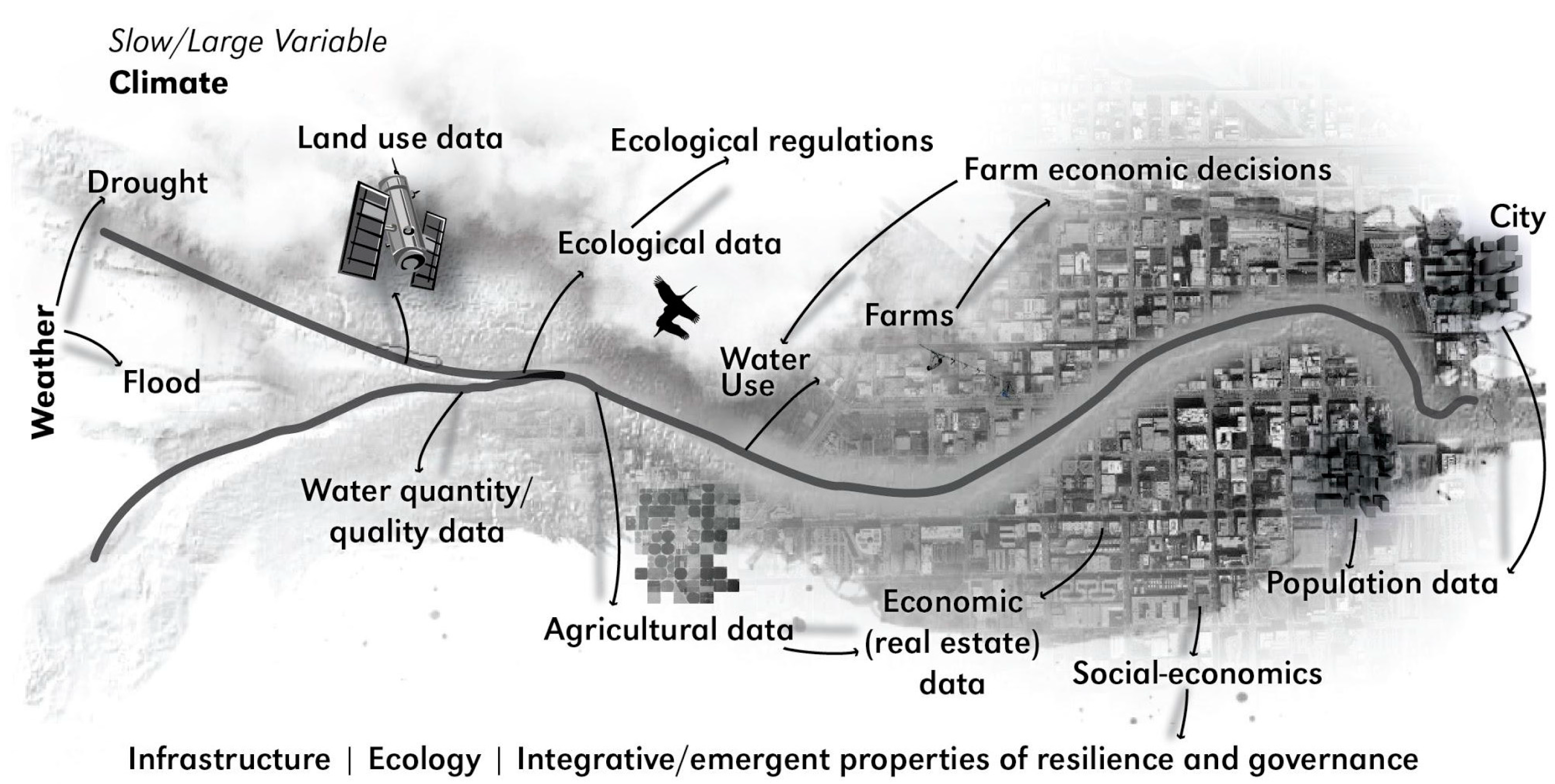

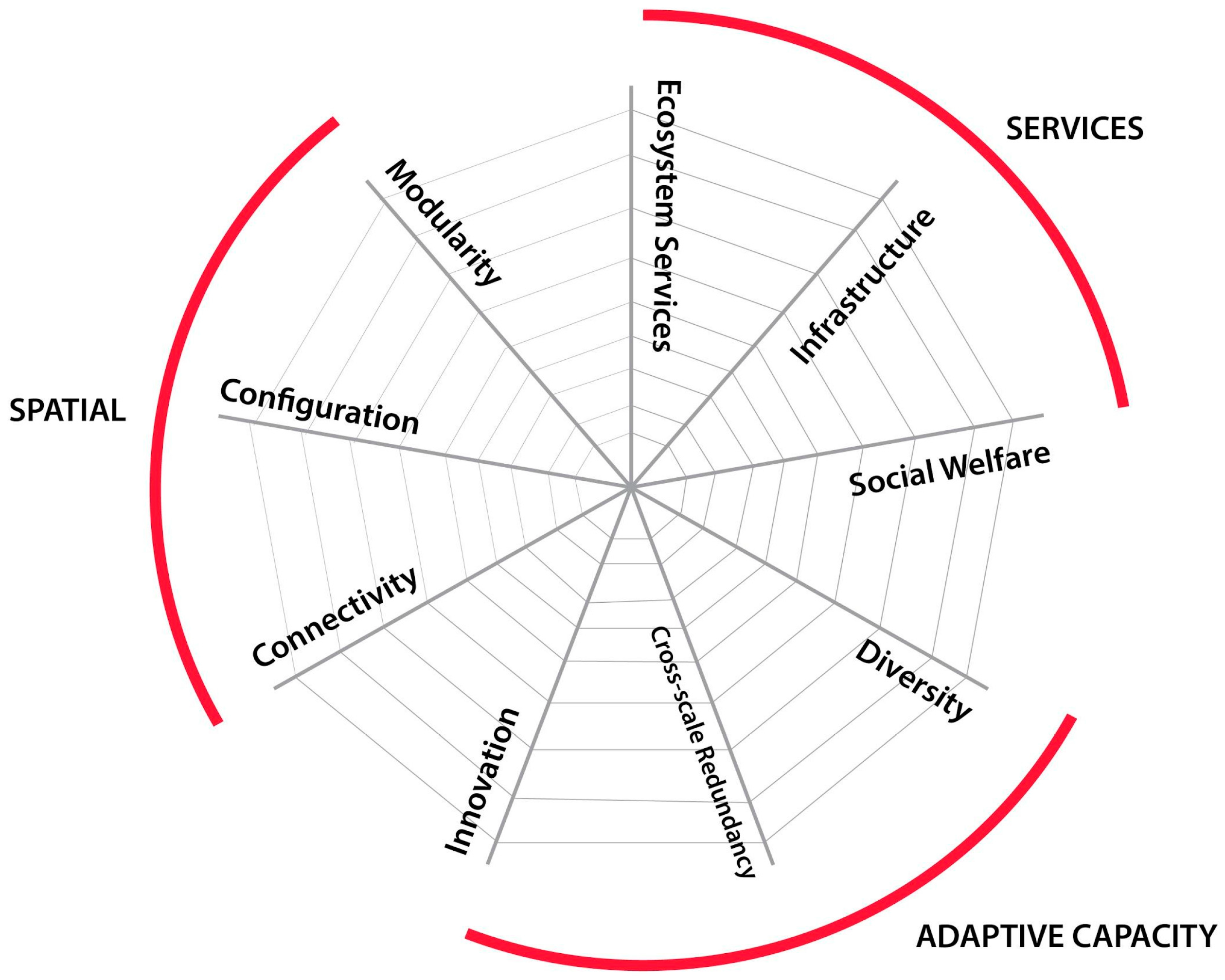
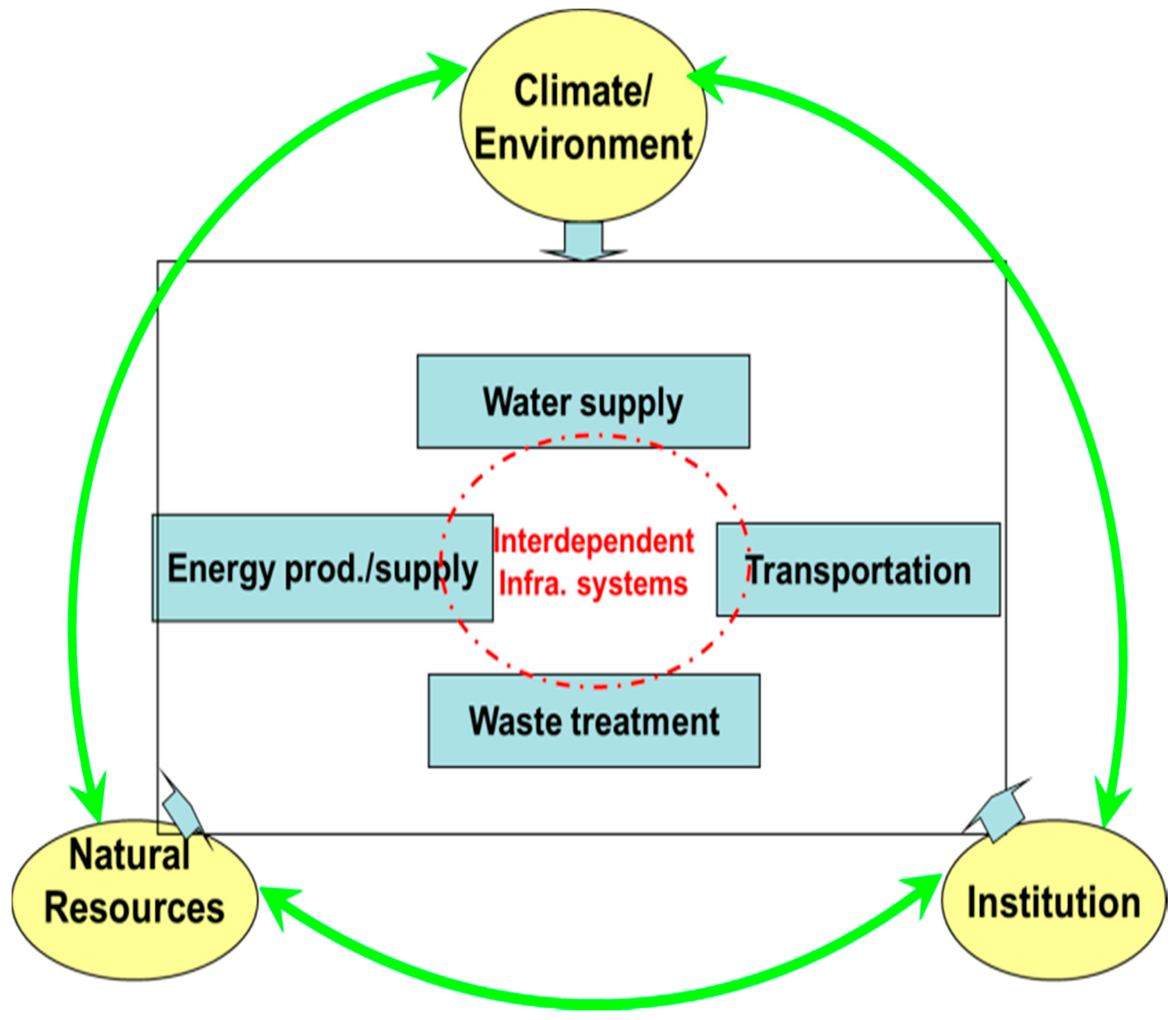
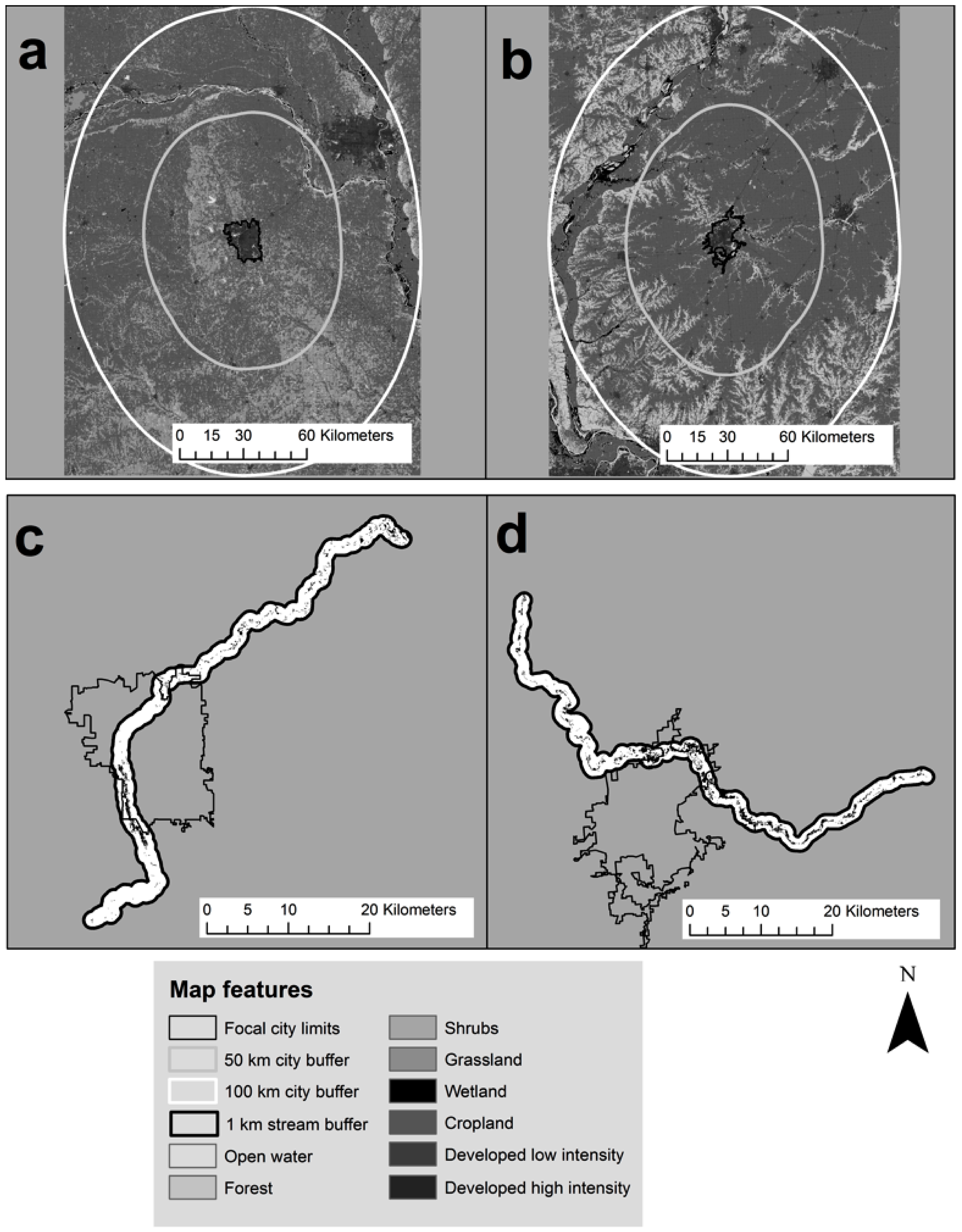
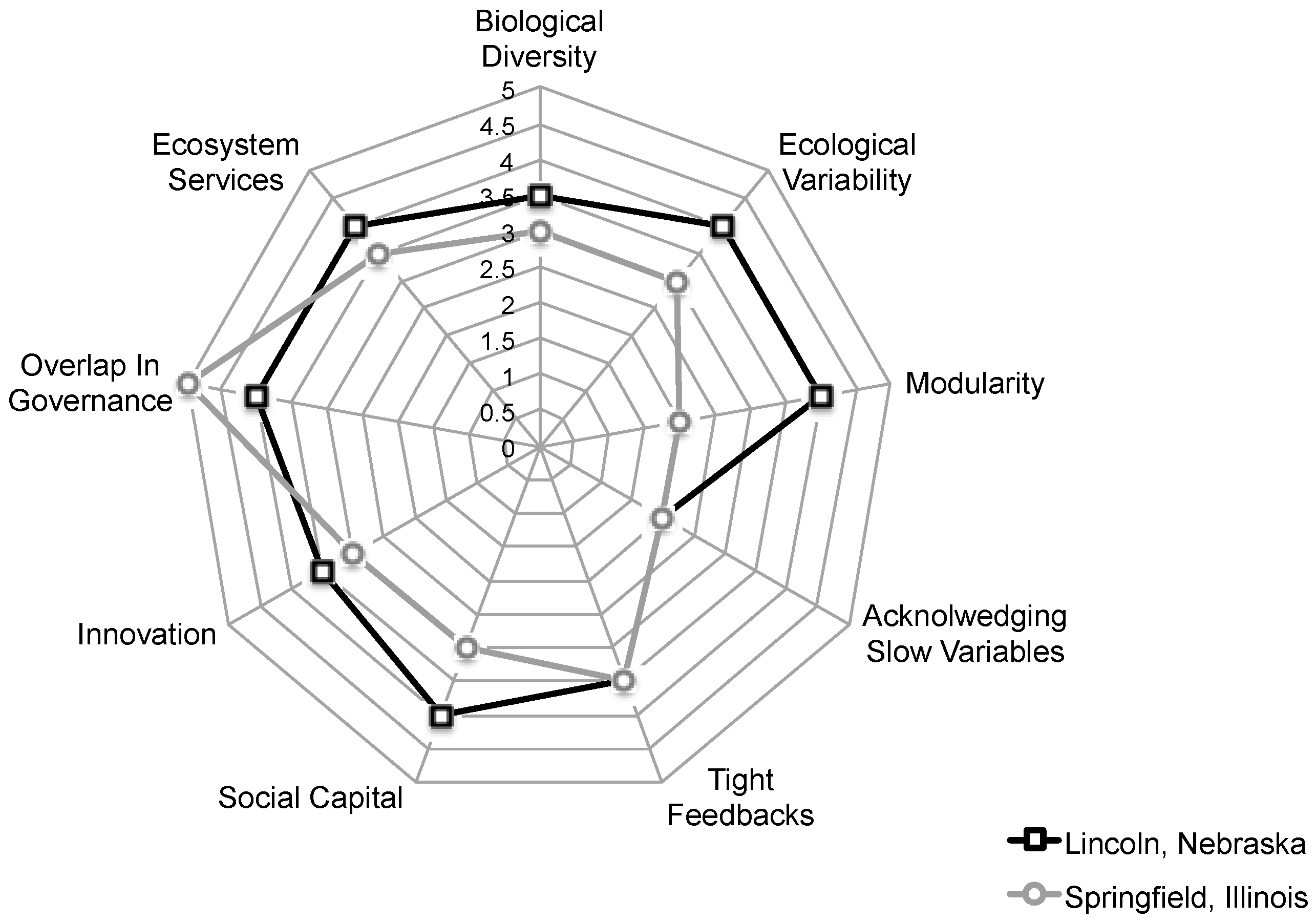
| Property | Definition | Assessment Metrics |
|---|---|---|
| Biological Diversity | The number and evenness of species, functional groups, and response to disturbance in the ecosystem | Diversity of native land covers, and rate land use change within city limits and around the city |
| Ecological Variability | Natural variability and fluctuations in ecological processes, structures, and populations | Presence of wetlands, which may indicate flood repression |
| Modularity | System components are connected to one another so that information is transferred effectively, but not so overly connected that shocks cause disproportionate damage | The degree to which the damage/loss of a single institution affects the city |
| Acknowledging Slow Variables | Incorporation of information about long-term outcomes that result from near-term decision making | Use of long-term time horizons in city planning; acknowledgement of system-specific slow variables in these plans |
| Tight Feedbacks | Feedbacks among critical system components respond quickly, allowing practitioners to avoid dangerous thresholds | Infrastructure and planning that ensures essential services, like water quality, is continuously maintained |
| Social Capital | The net sum of benefits generated from relationships among components in a system’s social network | Unemployment rate, poverty levels, voter participation, public servant approval ratings |
| Innovation | Degree of learning, experimentation, education, and locally developed rules in order to embrace change and creatively improve conditions | What proportion of the economy is due to new technology; ethnic, racial and gender diversity in business ownership and governance |
| Overlap in Governance | Institutions have redundancy in their roles and responsibilities | Multiple institutions are authorized to provide essential services in the case of natural and human disasters |
| Ecosystem Services | Essential and nonessential benefits people obtain from ecosystems | Accessibility to local agricultural lands, hunting and fishing, green spaces, wetlands |
| Variable | Lincoln, NE, USA | Springfield, IL, USA | National |
|---|---|---|---|
| Population | 272,996 | 116,809 | 318,900,000 |
| Population Annual % Change | 5.60% | 0.40% | 3.30% |
| Unemployment Rate | 2.10% | 4.60% | 6.2% |
| Gross Domestic Product (millions of USD) | 15,482 | 8714 | 17.914 × 1012 |
| Gross Domestic Product Annual % Change | 2.60% | −0.80% | 2.40% |
| Lincoln, NE, USA | Springfield, IL, USA | ||||
|---|---|---|---|---|---|
| Top Ten Employer | # Employees | % of Workers Employed | Top Ten Employer | # Employees | % of Workers Employed |
| State of Nebraska | 8988 | 22.54 | State of Illinois | 17,500 | 48.77 |
| Lincoln Public Schools | 7975 | 20.00 | Memorial Hospital | 4433 | 12.35 |
| University of Nebraska-Lincoln | 6179 | 15.50 | St. John’s Hospital | 3073 | 8.56 |
| Bryan Health | 3796 | 9.52 | Springfield Public Schools | 2189 | 6.10 |
| US Government | 3206 | 8.04 | Springfield Clinic | 1953 | 5.44 |
| City of Lincoln | 2589 | 6.49 | City of Springfield | 1510 | 4.21 |
| St. Elizabeth Regional Medical Center | 2350 | 5.89 | Southern Illinois University School of Medicine | 1485 | 4.14 |
| Burlington Northern Railroad | 2000 | 5.02 | University of Illinois at Springfield | 1435 | 4.00 |
| Madonna Rehabilitation Hospital | 1400 | 3.51 | BlueCross BlueShield | 1256 | 3.50 |
| B&R Stores | 1391 | 3.49 | Horace Mann | 1050 | 2.93 |
| Total # Employed by a Top 10 Employer | 39,874 | - | Total # Employed by a Top 10 Employer | 35,884 | -- |
© 2016 by the authors; licensee MDPI, Basel, Switzerland. This article is an open access article distributed under the terms and conditions of the Creative Commons Attribution (CC-BY) license (http://creativecommons.org/licenses/by/4.0/).
Share and Cite
Allen, C.R.; Birge, H.E.; Bartelt-Hunt, S.; Bevans, R.A.; Burnett, J.L.; Cosens, B.A.; Cai, X.; Garmestani, A.S.; Linkov, I.; Scott, E.A.; et al. Avoiding Decline: Fostering Resilience and Sustainability in Midsize Cities. Sustainability 2016, 8, 844. https://doi.org/10.3390/su8090844
Allen CR, Birge HE, Bartelt-Hunt S, Bevans RA, Burnett JL, Cosens BA, Cai X, Garmestani AS, Linkov I, Scott EA, et al. Avoiding Decline: Fostering Resilience and Sustainability in Midsize Cities. Sustainability. 2016; 8(9):844. https://doi.org/10.3390/su8090844
Chicago/Turabian StyleAllen, Craig R., Hannah E. Birge, Shannon Bartelt-Hunt, Rebecca A. Bevans, Jessica L. Burnett, Barbara A. Cosens, Ximing Cai, Ahjond S. Garmestani, Igor Linkov, Elizabeth A. Scott, and et al. 2016. "Avoiding Decline: Fostering Resilience and Sustainability in Midsize Cities" Sustainability 8, no. 9: 844. https://doi.org/10.3390/su8090844






